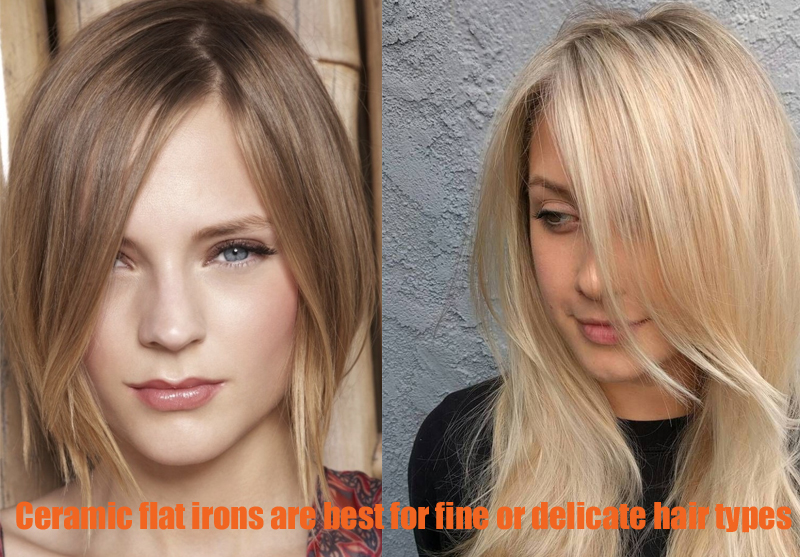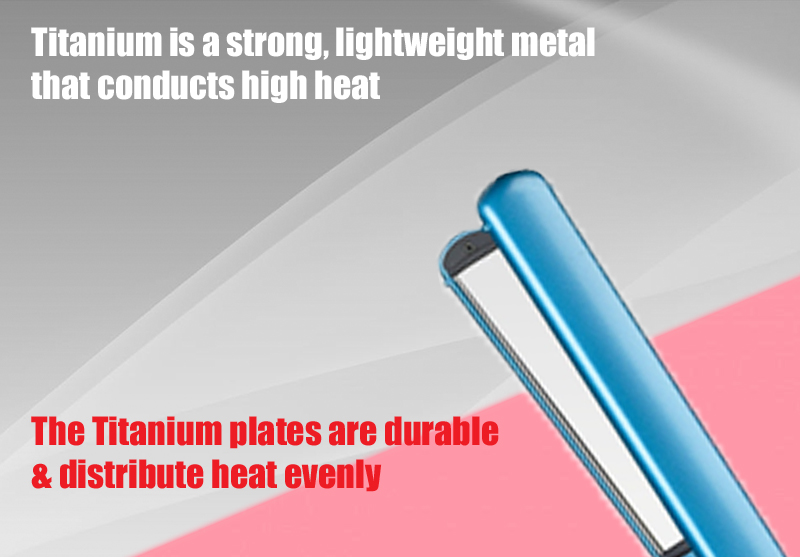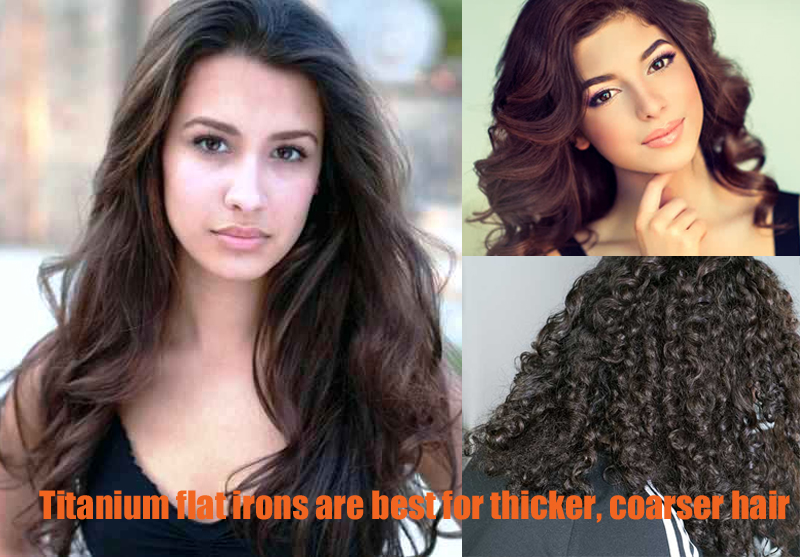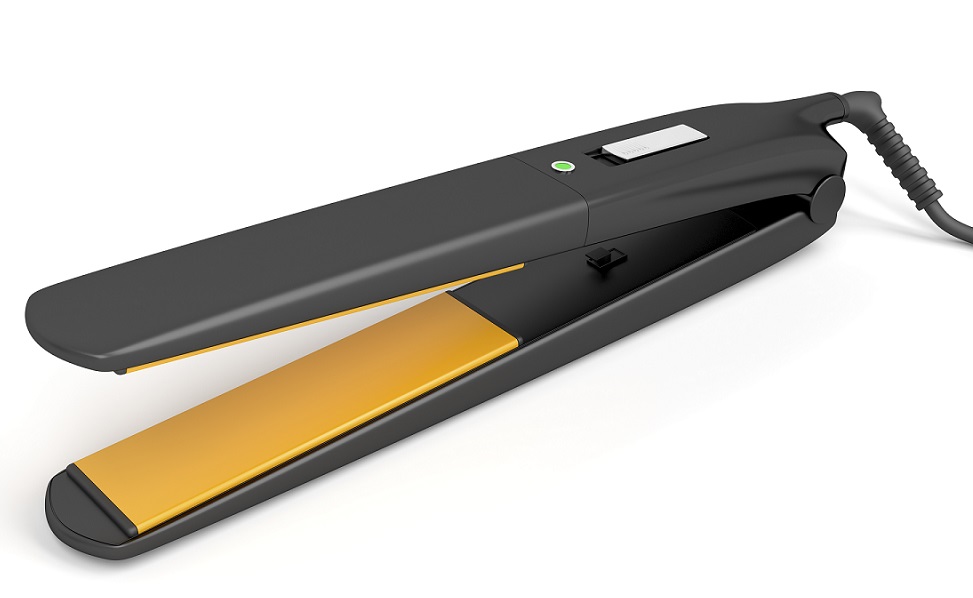Titanium (metal) and Ceramic are the most common kinds of material that hair straighteners’ plates are made from.
Both of them emit far-infrared heat, which dries hair from the inside out. They also generate negative ions to neutralize (or stabilize) dry hair.
But there are a few differences between them (like the heating mechanism), and that could be the factors you decide which one to buy, let’s find out.
Ceramic Hair Straightener Vs. Titanium Hair Straightener Comparison Table
Here’s a comparison table that highlights the differences between Ceramic and Titanium Hair Straighteners:
| Ceramic Hair Straightener | Titanium Hair Straightener | |
|---|---|---|
| Heat Conductivity | Distributes heat evenly, reducing potential damage | Conducts heat very quickly, leading to faster straightening time |
| Durability | Less durable compared to titanium, prone to chips and wear over time | Highly durable, less prone to scratches or wear over time |
| Price | More affordable and readily available | Generally more expensive due to its high performance and durability |
| Hair Type Suitability | Suitable for fine, delicate or damaged hair due to its even heat distribution | Ideal for thick, coarse, or stubborn hair that needs high heat |
| Heat Damage | Less potential for heat damage due to even heat distribution | Higher potential for heat damage if not used carefully |
| Results | Delivers silky, smooth results with less frizz | Yields professional-level results and shine |
Ceramic Flat Iron

According to Wikipedia, A ceramic is an inorganic, nonmetallic[a] solid material comprising metal, nonmetal, or metalloid atoms primarily held in ionic and covalent bonds.
The first form of this material dated back more than 27000 years ago. By properties of the material,non-erosive, heat conducted, it is ideal for making plates of flat irons.
Pros:
- Ceramic plates are very smooth.
- Even heat distribution
- Can work for a lot of hair types
Cons:
- Since your hair contains moisture, Ceramic plates may cause this evaporate and create hot stream through hair.
- Easily to break, crack if you accidentally drop them.
- Cheap ceramic flat iron have very thin layer of ceramic, which will be peeled after long time use. Avoid using this type of flat iron.
Ceramic flat irons are recommended for use at home. Ceramic plates are not just gentle on hair, but also the heat released from them.
Titanium Flat Iron

Basically, Titanium is a metal, so they are very strong and very durable.
Holding Titanium flat iron you feel it is a bit lighter than Ceramic models with the same size.
The Titanium plates conduct heat the best so that it will straighten hair quickly, but potentially cause hair damage. You should use a heat protection spray.
The research found out that frizz, damaged hair is overcharged with positive irons, the titanium plates once heated provide abundant negative ions, which will cure or neutralize those parts on hair, bring your hair to a better state.
With the same heat setting, say, 270F, your hair will receive more heat from Titanium flat ion than Ceramic ones.
If your hair is healthy (and it’s 3C or 4) and you do straightening daily, Titanium is for you.

One of the Titanium flat iron with a very high heat setting is Brazilian Heat After Dark, it suits very curly hair, especially African American hair, and can be used for permanent hair treatments like Brazilian keratin blowout.
Pros:
- Less expensive
- Stable heating
- Durable – it is okay if you accidentally drop your hair straightener
- Not corrosive
- Heated more evenly because of faster thermal conductivity and more intense than Ceramic
- Provide ionic output – Metal produces negative ions which is good for hair
- Give hair the shiniest and most flat-look
Cons:
- Metal doesn’t crack but it is scratched by metal
- The surface of Titanium plates is not smooth as Ceramic’s
- Easily to get build-up on its surface
Ceramic Or Titanium Flat Iron: Which one should I pick?
It really depends on your hair type. If your hair is easy to straighten, pick the Ceramic, otherwise, the Titanium is a better choice for those with long, thick, stubborn hair.
You also may consider the comfort and ease of use.
Whether you use Titanium or Ceramic Flat irons, they definitely cause hair damage, the more you style, the more it becomes less natural, so make sure don’t use them daily. Let your hair take a rest before they are silky straight again.
here’s a comparison table of the pros and cons for Ceramic and Titanium Hair Straighteners:
| Ceramic Hair Straightener | Titanium Hair Straightener | |
|---|---|---|
| Pros | ||
| Heat Distribution | Even and consistent heat distribution | Quick and high heat conductivity |
| Price | Generally more affordable | Offers professional-quality results |
| Hair Damage | Less likely to cause severe heat damage | Very effective on thick and coarse hair types |
| Results | Smooth and shiny finish | Can produce very straight, sleek results quickly |
| Cons | ||
| Durability | Can chip or crack over time | More expensive upfront cost |
| Potential for Damage | Requires multiple passes for thicker hair, increasing potential for damage | Can cause significant damage if not used correctly |
| Effectiveness | May struggle with very thick or coarse hair | Might be too intense for thin or damaged hair |
| Longevity of Results | Results may not last as long | Retains heat longer, so results can last longer |


So I think the thermal conductivity and ability to recover heat after sliding hair are factors make titanium different from ceramic. But while titanium produces irons the ceramic causes less damage to the hair. I know no hot tools are good for hair but the one cause less damage should be better. In this case which one?
I was given BaBylissPRO Nano this straightener as a birthday gift in January by the 3rd week this straightener would not heat up. I have been a BaByliss user since I was 16 and never had any issues. So when I experienced the misfortune I opted to call BaByliss for assistance in a replacement. I was told by the customer representative that I would be paying for shipping and handling both ways to send the straightener and for the replacement. I was so upset to hear this since I have developed a brand loyalty to them and be treated this way. I then opted to go back to Ulta to just replace the straightener that has a 4 year limited warranty. I now have a new BaByliss but do to customer service experience my loyalty to this brand has been tarnished and find myself thinking “I wonder what other straightners might be better than what I currently purchased?
Hi Susana it’s good to know that you replaced your straightener: https://www.hotstylingtoolguide.com/four-signs-that-tell-your-hair-straightener-has-reached-its-expiry-date/
A lots of things to consider to be better, durability, heat distribution and consistant heat and we can’t scientifically evaluate these factors (only the manufacturer they know and test the producct before release). Rather users’ experience will often determine which one is better, you can opt to other brands such as ghd platinum+ black styler.
I would change out the link for the Solia flat iron. The product at that link is no longer for a flat iron, but either an earphone or an electric razor. Some companies will change out the product name/image to something completely different to keep the high ratings (so the flat iron got good ratings, but now it makes it look like the razor/ear phone has good ones, though the reviews all say “straightener”…). Solia has their own amazon page instead of the JOVERS one you originally linked to.
I just removed the link. Thank a lot for letting me know.
I have fine, thick hair, that’s fairly straight already when air or blow dried. I’m wondering which straightener material would be best to curl my hair? Or would a curler in one of these materials be better?